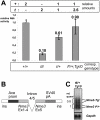The nucleoside diphosphate kinase gene Nme3 acts as quantitative trait locus promoting non-Mendelian inheritance
- PMID: 22438820
- PMCID: PMC3305403
- DOI: 10.1371/journal.pgen.1002567
The nucleoside diphosphate kinase gene Nme3 acts as quantitative trait locus promoting non-Mendelian inheritance
Abstract
The t-haplotype, a variant form of the t-complex region on mouse chromosome 17, acts as selfish genetic element and is transmitted at high frequencies (> 95%) from heterozygous (t/+) males to their offspring. This phenotype is termed transmission ratio distortion (TRD) and is caused by the interaction of the t-complex responder (Tcr) with several quantitative trait loci (QTL), the t-complex distorters (Tcd1 to Tcd4), all located within the t-haplotype region. Current data suggest that the distorters collectively impair motility of all sperm derived from t/+ males; t-sperm is rescued by the responder, whereas (+)-sperm remains partially dysfunctional. Recently we have identified two distorters as regulators of RHO small G proteins. Here we show that the nucleoside diphosphate kinase gene Nme3 acts as a QTL on TRD. Reduction of the Nme3 dosage by gene targeting of the wild-type allele enhanced the transmission rate of the t-haplotype and phenocopied distorter function. Genetic and biochemical analysis showed that the t-allele of Nme3 harbors a mutation (P89S) that compromises enzymatic activity of the protein and genetically acts as a hypomorph. Transgenic overexpression of the Nme3 t-allele reduced t-haplotype transmission, proving it to be a distorter. We propose that the NME3 protein interacts with RHO signaling cascades to impair sperm motility through hyperactivation of SMOK, the wild-type form of the responder. This deleterious effect of the distorters is counter-balanced by the responder, SMOK(Tcr), a dominant-negative protein kinase exclusively expressed in t-sperm, thus permitting selfish behaviour and preferential transmission of the t-haplotype. In addition, the previously reported association of NME family members with RHO signaling in somatic cell motility and metastasis, in conjunction with our data involving RHO signaling in sperm motility, suggests a functional conservation between mechanisms for motility control in somatic cells and spermatozoa.
Conflict of interest statement
The authors have declared that no competing interests exist.
Figures




References
-
- Silver LM. The peculiar journey of a selfish chromosome: mouse t haplotypes and meiotic drive. Trends Genet. 1993;9:250–254. - PubMed
-
- Schimenti J. Segregation distortion of mouse t haplotypes the molecular basis emerges. Trends Genet. 2000;16:240–243. - PubMed
-
- Lyon MF. Transmission ratio distortion in mice. Annu Rev Genet. 2003;37:393–408. - PubMed
-
- Katz DF, Erickson RP, Nathanson M. Beat frequency is bimodally distributed in spermatozoa from T/t12 mice. J Exp Zool. 1979;210:529–535. - PubMed
Publication types
MeSH terms
Substances
LinkOut - more resources
Full Text Sources
Other Literature Sources
Molecular Biology Databases

